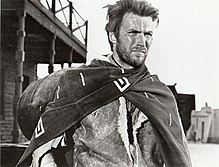
Clarence LeRoy Van Cleef Jr. was an American actor. He appeared in over 170 film and television roles in a career spanning nearly 40 years, but is best known as a star of Italian Spaghetti Westerns, particularly the Sergio Leone-directed Dollars Trilogy films For a Few Dollars More (1965) and The Good, the Bad and the Ugly (1966). He received a Golden Boot Award in 1983 for his contribution to the Western film and television genre.

The spaghetti Western is a broad subgenre of Western films produced in Europe. It emerged in the mid-1960s in the wake of Sergio Leone's filmmaking style and international box-office success. The term was used by foreign critics because most of these Westerns were produced and directed by Italians.
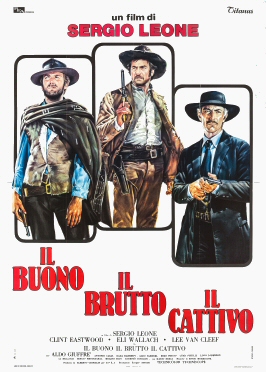
The Good, the Bad and the Ugly is a 1966 Italian epic spaghetti Western film directed by Sergio Leone and starring Clint Eastwood as "the Good", Lee Van Cleef as "the Bad", and Eli Wallach as "the Ugly". Its screenplay was written by Age & Scarpelli, Luciano Vincenzoni, and Leone, based on a story by Vincenzoni and Leone. Director of photography Tonino Delli Colli was responsible for the film's sweeping widescreen cinematography, and Ennio Morricone composed the film's score, including its main theme. It was an Italian-led production with co-producers in Spain, West Germany, and the United States. Most of the filming took place in Spain.

Sergio Leone was an Italian filmmaker, credited as the pioneer of the spaghetti Western genre. He is widely regarded as one of the most influential directors in the history of cinema.

Toshiro Mifune was a Japanese actor and producer. A winner of numerous awards and accolades over a lengthy career, Mifune is best known for starring in Akira Kurosawa's critically acclaimed jidaigeki films such as Rashomon (1950), Seven Samurai (1954), Throne of Blood (1957), The Hidden Fortress (1958) and Yojimbo (1961). He also portrayed Miyamoto Musashi in Hiroshi Inagaki's Samurai Trilogy (1954–1956), Lord Toranaga in the NBC television miniseries Shōgun, and Admiral Isoroku Yamamoto in three different films. He is widely considered one of the greatest actors of all time.

Yojimbo is a 1961 Japanese samurai film directed by Akira Kurosawa, who also co-wrote the screenplay and was one of the producers. The film stars Toshiro Mifune, Tatsuya Nakadai, Yoko Tsukasa, Isuzu Yamada, Daisuke Katō, Takashi Shimura, Kamatari Fujiwara, and Atsushi Watanabe. In the film, a rōnin arrives in a small town where competing crime lords fight for supremacy. The two bosses each try to hire the newcomer as a bodyguard.

A Fistful of Dollars is a 1964 spaghetti Western film directed by Sergio Leone and starring Clint Eastwood in his first leading role, alongside Gian Maria Volonté, Marianne Koch, Wolfgang Lukschy, Sieghardt Rupp, José Calvo, Antonio Prieto and Joseph Egger. The film, an international co-production between Italy, West Germany and Spain, was filmed on a low budget, and Eastwood was paid $15,000 for his role.

For a Few Dollars More is a 1965 Spaghetti Western film directed by Sergio Leone. It stars Clint Eastwood and Lee Van Cleef as bounty hunters and Gian Maria Volonté as the primary villain. German actor Klaus Kinski plays a supporting role as a secondary villain. The film was an international co-production between Italy, West Germany, and Spain. The film was released in the United States in 1967, and is the second instillment of what is commonly known as the Dollars Trilogy.

Duck, You Sucker!, also known as A Fistful of Dynamite and Once Upon a Time ... the Revolution, is a 1971 epic Zapata Western film directed and co-written by Sergio Leone and starring Rod Steiger, James Coburn, and Romolo Valli.

The Dollars Trilogy, also known as the Man with No Name Trilogy, is an Italian film series consisting of three Spaghetti Western films directed by Sergio Leone. The films are titled A Fistful of Dollars (1964), For a Few Dollars More (1965) and The Good, the Bad and the Ugly (1966). Their English versions were distributed by United Artists, while the Italian ones were distributed by Unidis and PEA.

Last Man Standing is a 1996 American action film written and directed by Walter Hill and starring Bruce Willis, Christopher Walken, and Bruce Dern. It is a credited remake of Akira Kurosawa's Yojimbo.
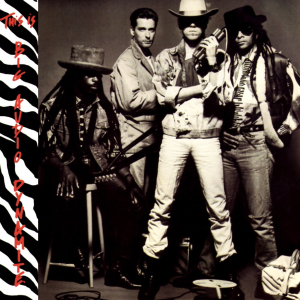
This Is Big Audio Dynamite is the debut studio album by the English band Big Audio Dynamite, led by Mick Jones, the former lead guitarist and co-lead vocalist of the Clash. It was released on 1 November 1985 by Columbia Records. The album peaked at No. 27 on the UK Albums Chart and at No. 103 on the Billboard 200, and was certified gold by the British Phonographic Industry (BPI). Three singles were released from the album, all of which charted in the UK. "The Bottom Line" released a month before the album, barely made the Top 100, peaking at No. 97, becoming their lowest charting single, whereas its follow-up single "E=MC²" released in 1986, became their only Top 20 hit, peaking at No. 11, and becoming their best-selling single. The final single from the album, "Medicine Show" also released in 1986, became their last single to chart within the Top 40 under the original line-up, peaking at No. 29. The music video for "Medicine Show", directed by Don Letts, featured two other former members of the Clash, Joe Strummer and Paul Simonon as police officers as well as John Lydon of the Sex Pistols and Public Image Ltd.
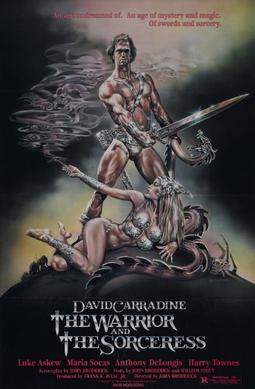
The Warrior and the Sorceress is a 1984 Argentine-American fantasy action film directed by John C. Broderick and starring David Carradine, María Socas and Luke Askew. It was written by Broderick and William Stout (story).

Zatoichi Meets Yojimbo (座頭市と用心棒) is a 1970 Japanese drama film directed by Kihachi Okamoto.

Benito Stefanelli was an Italian film actor, stuntman and weapons master who made over 60 appearances in film between 1955 and 1991.
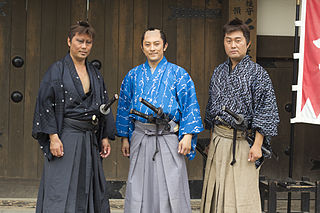
Chanbara (チャンバラ), also commonly spelled "chambara", meaning "sword fighting" films, denotes the Japanese film genre called samurai cinema in English and is roughly equivalent to Western and swashbuckler films. Chanbara is a sub-category of jidaigeki, which equates to period drama. Jidaigeki may refer to a story set in a historical period, though not necessarily dealing with a samurai character or depicting swordplay.

Dollar for the Dead is a 1998 American TNT Western television film. Film directed and written by Gene Quintano and starring Emilio Estevez. It is the third Western film in which Estevez stars. Film also stars William Forsythe, Joaquim de Almeida, Jonathan Banks, Ed Lauter and Howie Long. Actor Jordi Mollà nominated for Fotogramas de Plata award.
A number of Akira Kurosawa's films have been remade.

Nazzareno Natale was an Italian actor.

"Medicine Show" is a song by English band Big Audio Dynamite, released as both a 7" and 12" single from their debut studio album, This Is Big Audio Dynamite (1985). Written by Mick Jones and Don Letts about a fictitious medicine show, and following the success of "E=MC2", "Medicine Show" was released as the third and final single from the album, peaking at No. 29 on the UK Singles Chart, and No. 42 on Billboard's Modern Rock Tracks chart. It was their final top 40 single in the UK with the original line-up.



